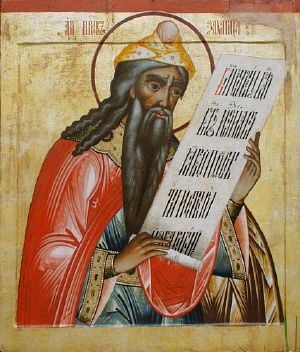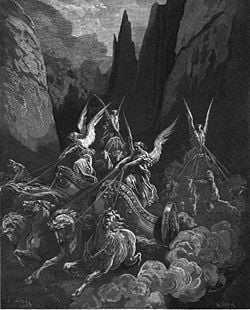Book of Zechariah
| Tanakh Torah | Nevi'im | Ketuvim Books of Nevi'im |
| First Prophets |
|---|
| 1. Joshua |
| 2. Judges |
| 3. Samuel |
| 4. Kings |
| Later Prophets |
| 5. Isaiah |
| 6. Jeremiah |
| 7. Ezekiel |
| 8. 12 minor prophets |
The Book of Zechariah is a book of the Bible Old Testament and Jewish Tanakh attributed to the prophet Zechariah, who left after the Babylonian exile during the time when the Temple of Jerusalem was being rebuilt.
Historical Context
Zechariah’s ministry took place during the reign of Darius the Great (Zechariah 1:1), and was contemporary with Haggai in a post-exilic world after the fall of Jerusalem in 587 B.C.E.[1] Ezekiel and Jeremiah both wrote prior to the fall of Jerusalem, while continuing to prophesy during the period of exile. Scholars believe Ezekiel, with his blending of ceremony and vision, heavily influenced the visionary works of Zechariah 1-8.[2] Zechariah is specific about dating his writing, and most scholars put that date at (520-518 B.C.E.).
During the exile many Jews were taken to Babylon, where Jeremiah told them to settle and make their homes (Jeremiah 29), suggesting they would spend a long period of time there. Eventually freedom did come to many Israelites, when Cyrus the Great overthrew the Babylonians and allowed the Jews to return to Jerusalem. The first wave of the return took place under a leader known as Shebazzar. After the death of Cyrus in 530 B.C.E., Darius consolidated power and took office in 522 B.C.E. His system divided the different colonies of the empire into easily manageable districts overseen by governors. Here, Zerubbabel comes into the story, a descendant of King David appointed by Darius as governor over the district of Yehud (Judah). Zechariah also emerged during Darius' reign, centering around the rebuilding of the temple.
Unlike the Babylonians, the Persian Empire went to great lengths to keep cordial relations with their vassal states. The rebuilding of the temple was encouraged by the Persians in hopes that it would strengthen the authorities in local contexts. This policy was good politics on the part of the Persians, and the Jews viewed it as a blessing by Yahweh.
The Prophet
Zechariah's name means "God has remembered." He describes himself (1:1) as "the son of Berechiah, the son of Iddo." In Ezra 5:1 and 6:14 he is called "the son of Iddo," who was properly his grandfather. His prophetical career began in the second year of Darius, king of Persia, about sixteen years after the return of the first company from their Babylonian exile. He was contemporary with Haggai (Ezra 5:1).
In the New Testament, Zechariah is confused with another prophet by the same name, Zechariah son of Jehoiada, who was killed in the Temple area for speaking out against King Jehoash (2 Chronicles 24:20-21). In in Matthew 23:35, Luke 11:50-51 Jesus apparently refers to this earlier Zechariah as Zechariah son of Berechiah.
A tradition preserved in the Lives of the Prophets states that Zechariah actually died a peaceful death "when he had attained a great age" and was buried near Haggai.
Authorship
Although there is no doubt that Zechariah was a historical person and that some of his prophecies are preserved in the Book of Zechariah, not all scholars accept the book as the writings of one individual. In this view, chapters 1–8 are treated as being the work of the "original" Zechariah. His prophecies and writings were collected by his disciples and his prophetic mantle handed down to other students, who bear responsibility for chapters 9–14. In this view, rather than a single author, there was a prophetical tradition of Zechariah after the "original" prophet. The character of the character of the original prophet is to be found within the lines of chapters 1–8. Others, however, see no reason to doubt that the entire book was written by the historical Zechariah.
Composition
The return from exile is the theological premise of prophet's visions in chapters 1-6. Chapters 7–8 address the quality of life God wants his renewed people to enjoy, containing many encouraging promises to them. Chapters 9-14 comprise two "oracles" of the future.
Chapters 1 to 6
The book begins with a preface (1:1-6), which recalls the nation's past history, for the purpose of presenting a solemn warning to the present generation. Then follows a series of eight visions (1:7-6:8), succeeding one another in one night, which may be regarded as a symbolic history of Israel, intended to furnish consolation to the returned exiles and stir up hope in their minds. The symbolic action, the crowning of Joshua (6:9-15), describes how the kingdoms of the world become the kingdom of God's Messiah.
Chapters 7 and 8
Chapters 7 and 8, delivered two years later, are an answer to the question whether the days of mourning for the destruction of the city should be kept any longer, and an encouraging address to the people, assuring them of God's presence and blessing.
Chapters 9 to 14
This section consists of two "oracles" or "burdens":
- The first oracle (ch. 9-11) gives an outline of the course of God's providential dealings with his people down to the time of the Advent.
- The second oracle (ch. 12-14) points out the glories that await Israel in "the latter day," the final conflict and triumph of God's kingdom.
Themes
The purpose of this book is not strictly historical but theological and pastoral. The main emphasis is that God is at work and plans to live again with His people in Jerusalem. He will save them from their enemies and cleanse them from sin.
Zechariah's concern for purity is apparent in the temple, priesthood and all areas of life as the prophecy gradually eliminates the influence of the governor in favour of the high priest, and the sanctuary becomes ever more clearly the centre of messianic fulfillment. The prominence of prophecy is quite apparent in Zechariah, but it is also true that Zechariah (along with Haggai) allows prophecy to yield to the priesthood; this is particularly apparent in comparing Zechariah to "Third Isaiah" (chapters 55–56 of the Book of Isaiah), whose author was active sometime after the first return from exile.
Most Christian commentators read the series of predictions in chapters 7 to 14 as Messianic prophecies, either directly or indirectly. These chapters helped the writers of the Gospels understand Jesus’ suffering, death and resurrection, which they quoted as they wrote of Jesus’ final days. Much of the Book of Revelation, which narrates the denouement of history, is also colored by images in Zechariah.
Notes
- ↑ Carol L. Myers and Eric M. Myers, Haggai, Zechariah 1-8: The Anchor Bible. Garden City, Doubleday and Company Inc., 1987. ISBN 978-0385144827. Page 183.
- ↑ Myers, p. 30.
ReferencesISBN links support NWE through referral fees
- The Student Bible, NIV. Michigan: Zondervan Publishing House, 1992.
- D. Guthrie, (ed.) New Bible Commentary. New York: Eerdmans Publishing Company, 1970.
- Stephen G. Dempster, Dominion And Dynasty: A Theology Of The Hebrew Bible. Illinois: Intervarsity Press, 2003. ISBN 978-0830826155
- Carroll Stuhlmueller, Haggai and Zechariah: Rebuilding With Hope. Edinburgh: The Handsel Press Ltd., 1988. ISBN 978-0905312750.
- This entry incorporates text from the public domain Easton's Bible Dictionary, originally published in 1897.
External links
Translations
- Zechariah (Judaica Press) translation with Rashi's commentary at Chabad.org
- Online Bible at GospelHall.org (ESV, KJV, Darby, American Standard Version, Bible in Basic English)
| Preceded by: Haggai |
Hebrew Bible | Followed by Malachi |
| Christian Old Testament |
| |||||||||||||||||
Credits
New World Encyclopedia writers and editors rewrote and completed the Wikipedia article in accordance with New World Encyclopedia standards. This article abides by terms of the Creative Commons CC-by-sa 3.0 License (CC-by-sa), which may be used and disseminated with proper attribution. Credit is due under the terms of this license that can reference both the New World Encyclopedia contributors and the selfless volunteer contributors of the Wikimedia Foundation. To cite this article click here for a list of acceptable citing formats.The history of earlier contributions by wikipedians is accessible to researchers here:
The history of this article since it was imported to New World Encyclopedia:
Note: Some restrictions may apply to use of individual images which are separately licensed.

